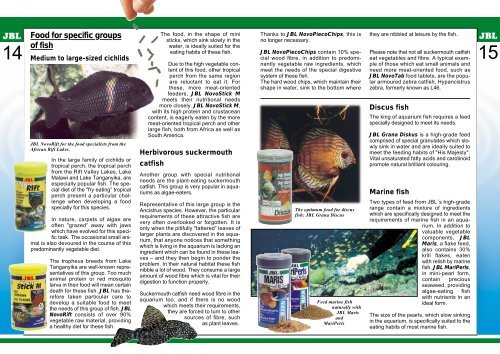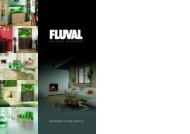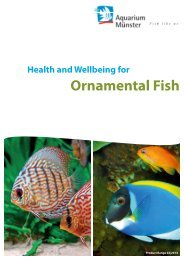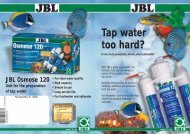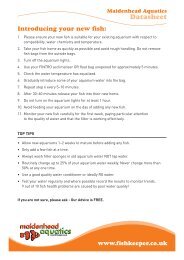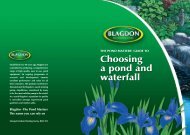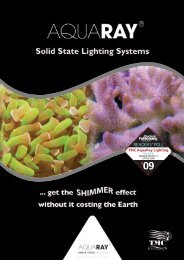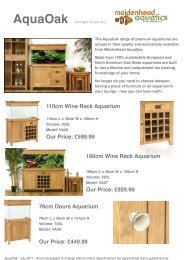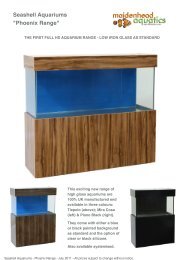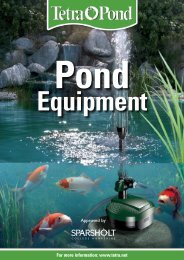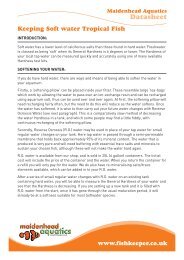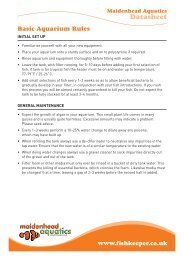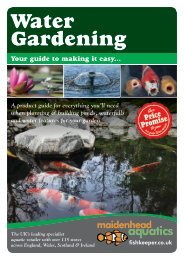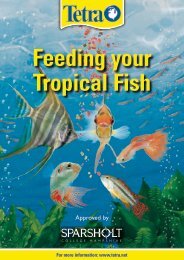Correct Feeding of Aquarium Fish(7.17MB)
Correct Feeding of Aquarium Fish(7.17MB)
Correct Feeding of Aquarium Fish(7.17MB)
You also want an ePaper? Increase the reach of your titles
YUMPU automatically turns print PDFs into web optimized ePapers that Google loves.
Food for specific groups<br />
<strong>of</strong> fish<br />
JBL NovoPiecoChips contain 10% spe- Please note that not all suckermouth catfish<br />
14 Medium to large-sized cichlids<br />
cial wood fibre, in addition to predomi- eat vegetables and fibre. A typical exam- 15<br />
JBL NovoRift for the food specialists from the<br />
African Rift Lakes.<br />
In the large family <strong>of</strong> cichlids or<br />
tropical perch, the tropical perch<br />
from the Rift Valley Lakes, Lake<br />
Malawi and Lake Tanganyika, are<br />
especially popular fish. The special<br />
diet <strong>of</strong> the "fry eating” tropical<br />
perch present a particular challenge<br />
when developing a food<br />
specially for this species.<br />
In nature, carpets <strong>of</strong> algae are<br />
<strong>of</strong>ten "grazed” away with jaws<br />
which have evolved for this specific<br />
task. The occasional small animal<br />
is also devoured in the course <strong>of</strong> this<br />
predominantly vegetable diet.<br />
The tropheus breeds from Lake<br />
Tanganyika are well-known representatives<br />
<strong>of</strong> this group. Too much<br />
animal protein or red mosquito<br />
larva in their food will mean certain<br />
death for these fish. JBL has therefore<br />
taken particular care to<br />
develop a suitable food to meet<br />
the needs <strong>of</strong> this group <strong>of</strong> fish. JBL<br />
NovoRift consists <strong>of</strong> over 90%<br />
vegetable raw material, providing<br />
a healthy diet for these fish.<br />
The food, in the shape <strong>of</strong> mini<br />
sticks, which sink slowly in the<br />
water, is ideally suited for the<br />
eating habits <strong>of</strong> these fish.<br />
Due to the high vegetable content<br />
<strong>of</strong> this food, other tropical<br />
perch from the same region<br />
are reluctant to eat it. For<br />
these, more meat-oriented<br />
feeders, JBL NovoStick M<br />
meets their nutritional needs<br />
more closely. JBL NovoStick M,<br />
with its high protein and crustacean<br />
content, is eagerly eaten by the more<br />
meat-oriented tropical perch and other<br />
large fish, both from Africa as well as<br />
South America.<br />
Herbivorous suckermouth<br />
catfish<br />
Another group with special nutritional<br />
needs are the plant-eating suckermouth<br />
catfish. This group is very popular in aquariums<br />
as algae-eaters.<br />
Representative <strong>of</strong> this large group is the<br />
Ancistrus species. However, the particular<br />
requirements <strong>of</strong> these attractive fish are<br />
very <strong>of</strong>ten overlooked or forgotten. It is<br />
only when the pitifully "tattered” leaves <strong>of</strong><br />
larger plants are discovered in the aquarium,<br />
that anyone notices that something<br />
which is living in the aquarium is lacking an<br />
ingredient which can be found in these leaves<br />
– and they then begin to ponder the<br />
problem. In their natural habitat these fish<br />
nibble a lot <strong>of</strong> wood. They consume a large<br />
amount <strong>of</strong> wood fibre which is vital for their<br />
digestion to function properly.<br />
Suckermouth catfish need wood fibre in the<br />
aquarium too, and if there is no wood<br />
which meets their requirements,<br />
they are forced to turn to other<br />
sources <strong>of</strong> fibre, such<br />
as plant leaves.<br />
Thanks to JBL NovoPiecoChips, this is<br />
no longer necessary.<br />
nantly vegetable raw ingredients, which<br />
meet the needs <strong>of</strong> the special digestive<br />
system <strong>of</strong> these fish.<br />
The hard wood chips, which maintain their<br />
shape in water, sink to the bottom where<br />
The optimum food for discus<br />
fish: JBL Grana Discus<br />
Feed marine fish<br />
naturally with<br />
JBL Maris<br />
and<br />
MariPerls<br />
they are nibbled at leisure by the fish.<br />
ple <strong>of</strong> those which eat small animals and<br />
need more meat-oriented food, such as<br />
JBL NovoTab food tablets, are the popular<br />
armoured zebra catfish, Hypancistrus<br />
zebra, formerly known as L46.<br />
Discus fish<br />
The king <strong>of</strong> aquarium fish requires a feed<br />
specially designed to meet its needs.<br />
JBL Grana Diskus is a high-grade feed<br />
comprised <strong>of</strong> special granulates which slowly<br />
sink in water and are ideally suited to<br />
meet the feeding habits <strong>of</strong> "His Majesty".<br />
Vital unsaturated fatty acids and carotinoid<br />
promote natural brilliant colouring.<br />
Marine fish<br />
Two types <strong>of</strong> feed from JBL´s high-grade<br />
range contain a mixture <strong>of</strong> ingredients<br />
which are specifically designed to meet the<br />
requirements <strong>of</strong> marine fish in an aquarium.<br />
In addition to<br />
valuable vegetable<br />
components, JBL<br />
Maris, a flake feed,<br />
also contains 30%<br />
krill flakes, eaten<br />
with relish by marine<br />
fish. JBL MariPerls,<br />
in mini-pearl form,<br />
contain precious<br />
seaweed, providing<br />
algae-eating fish<br />
with nutrients in an<br />
ideal form.<br />
The size <strong>of</strong> the pearls, which slow sinking<br />
in the aquarium, is specifically suited to the<br />
eating habits <strong>of</strong> most marine fish.


